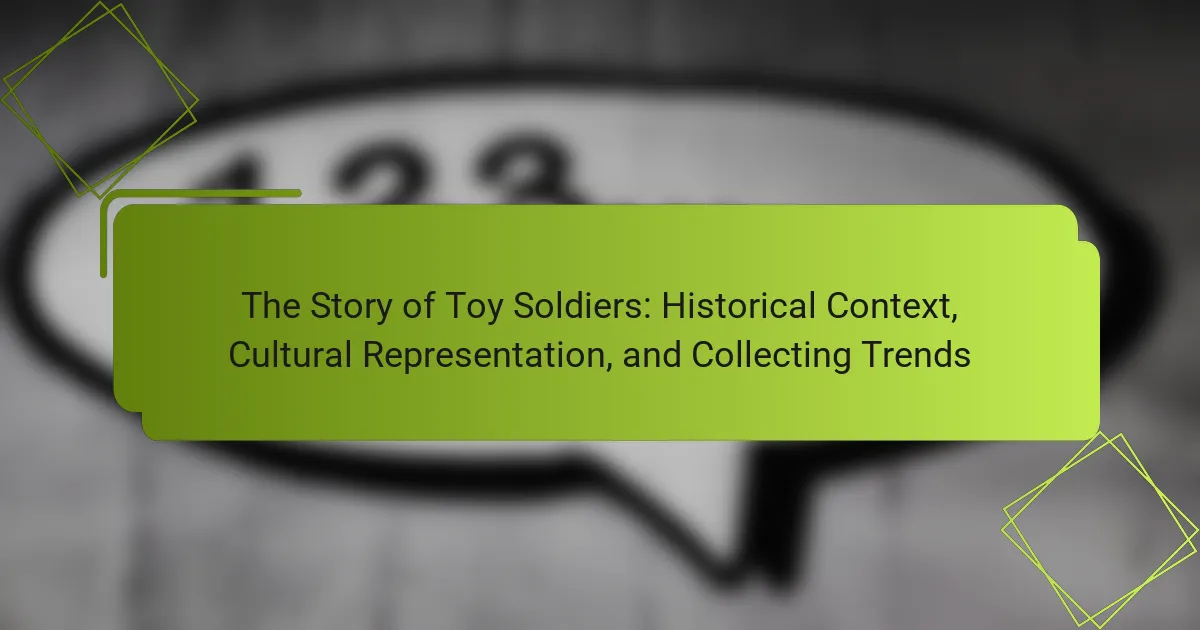
What are Toy Soldiers and Their Historical Significance?
Toy soldiers are miniature figures representing military personnel, often used for play or collection. They originated in the early 19th century, primarily in Europe. The first toy soldiers were made of lead and depicted various military units. These figures served as tools for children’s imaginative play and education about warfare. During the 20th century, their production expanded to include plastic and other materials. Toy soldiers also gained popularity among collectors, reflecting historical events and cultural representations. Their significance lies in their ability to represent history, nostalgia, and the evolution of toy manufacturing. Collectors often seek specific models that reflect historical accuracy or unique design.
How did Toy Soldiers originate and evolve over time?
Toy soldiers originated in the early 19th century as miniature representations of military figures. The first known mass-produced toy soldiers were made in Germany around 1810. These figures were typically crafted from lead and painted by hand. They gained popularity as children began to use them for imaginative play.
Over time, toy soldiers evolved in materials, transitioning from lead to plastic in the mid-20th century. This change made them safer and more affordable. The introduction of injection molding allowed for mass production, increasing variety and accessibility.
In the 1960s and 1970s, toy soldiers became associated with popular culture, appearing in films and television. Collecting toy soldiers emerged as a hobby, leading to specialized production of historical and fantasy figures. Today, toy soldiers are produced in various styles, representing different eras and cultures. They continue to be popular among children and collectors alike.
What historical events influenced the creation of Toy Soldiers?
The creation of toy soldiers was influenced by various historical events. The Napoleonic Wars in the early 19th century popularized the use of military miniatures. These miniatures were originally used for military strategy and training. The rise of nationalism and military parades also contributed to their popularity. In the 20th century, World War I and World War II led to increased interest in military-themed toys. The depiction of soldiers in popular culture further fueled demand. The post-war era saw a boom in plastic production, making toy soldiers more accessible. These factors collectively shaped the evolution of toy soldiers as collectibles and play items.
How have manufacturing techniques changed the production of Toy Soldiers?
Manufacturing techniques have significantly transformed the production of toy soldiers. Advances in injection molding have allowed for more intricate designs and faster production times. Modern materials, such as high-quality plastics, enhance durability and detail. Automation in factories has increased efficiency and reduced labor costs. Additionally, digital sculpting technology enables precise and customizable figures. These changes have led to a wider variety of toy soldier styles and themes. The evolution from handcrafted to mass-produced models has made toy soldiers more accessible to consumers. Overall, these manufacturing innovations have reshaped the toy soldier market.
Why are Toy Soldiers considered cultural artifacts?
Toy soldiers are considered cultural artifacts because they reflect societal values and historical contexts. These miniature figures have been used for centuries in various cultures. They often symbolize childhood play, military history, and social norms. The design and materials of toy soldiers can indicate technological advancements and artistic trends of their time. For example, lead toy soldiers were popular in the 19th century, showcasing craftsmanship and industrial production methods. Additionally, they can represent the militarization of society and the glorification of war. Their presence in popular culture, such as films and literature, further solidifies their status as cultural artifacts. Overall, toy soldiers serve as a lens through which to understand historical and cultural narratives.
What role do Toy Soldiers play in childhood play and imagination?
Toy soldiers serve as tools for imaginative play in childhood. They encourage storytelling and role-playing scenarios. Children often create elaborate narratives involving battles and adventures. These scenarios help develop creativity and problem-solving skills. Toy soldiers also foster social interaction during group play. Kids learn teamwork and negotiation through shared play experiences. Additionally, they can reflect cultural themes and historical events. This connection to history can enhance learning and understanding of the world. Research shows that imaginative play contributes to cognitive and emotional development in children.
How do Toy Soldiers reflect societal values and conflicts?
Toy soldiers reflect societal values and conflicts by embodying the ideals of heroism and nationalism. They often represent military figures, reflecting a society’s view on war and peace. These toys can symbolize childhood innocence while simultaneously portraying the realities of conflict. Historical events influence their design and popularity, such as World War II, which saw a surge in soldier toys. The depiction of soldiers can also reflect cultural narratives around masculinity and bravery. In times of peace, toy soldiers may promote themes of teamwork and camaraderie. Conversely, during conflicts, they can serve as a reminder of the sacrifices made. Overall, toy soldiers serve as a lens through which societal attitudes toward conflict and valor are expressed.

How are Toy Soldiers Represented in Popular Culture?
Toy soldiers are represented in popular culture through various media, including films, literature, and toys. They often symbolize childhood, imagination, and the innocence of play. Movies like “Toy Story” highlight their animated lives and adventures. Literature often portrays them as heroic figures in battles, reflecting themes of bravery and sacrifice. In addition, toy soldier collectibles have become a niche market, appealing to both children and [censured] enthusiasts. The imagery of toy soldiers frequently appears in art and advertising, reinforcing their cultural significance. Overall, they embody nostalgia and the intersection of play and conflict in society.
What are some notable representations of Toy Soldiers in media?
Notable representations of toy soldiers in media include films, television shows, and video games. In the film “Toy Story,” toy soldiers are depicted as loyal and strategic characters. The “Small Soldiers” movie features toy soldiers brought to life, engaging in combat. The video game series “Army Men” showcases various toy soldier battles and missions. In the animated series “G.I. Joe,” toy soldiers are represented as action figures with elaborate backstories. These portrayals reflect cultural perceptions of bravery and heroism associated with toy soldiers.
How have films and literature portrayed Toy Soldiers?
Films and literature have portrayed toy soldiers as symbols of childhood imagination and conflict. They often represent the innocence of play juxtaposed with themes of war and heroism. In films like “Toy Story,” toy soldiers embody loyalty and teamwork. Literature often explores their roles in adventures or moral lessons. Classic stories feature them in battles, highlighting bravery and sacrifice. These portrayals reflect societal views on war and childhood. They evoke nostalgia while critiquing militarism. Overall, toy soldiers serve as complex symbols in various narratives.
What impact do video games have on the perception of Toy Soldiers?
Video games significantly influence the perception of Toy Soldiers. They often portray these figures in dynamic, interactive scenarios. This representation enhances their appeal to younger audiences. Video games frequently depict Toy Soldiers as heroic figures in combat situations. Such portrayals can romanticize military themes and warfare. Studies show that exposure to these narratives can shape children’s understanding of conflict. Players may develop a sense of nostalgia linked to these toys. Additionally, video games can introduce new generations to the concept of Toy Soldiers. This interaction can lead to increased interest in collecting and playing with them.
Why do Toy Soldiers resonate with collectors and enthusiasts?
Toy soldiers resonate with collectors and enthusiasts due to their nostalgic value and historical significance. Many collectors grew up playing with these figures, creating a strong emotional connection. The figures often represent historical battles and military themes, appealing to history buffs. Collectors appreciate the craftsmanship and detail in the models. Some toy soldiers are produced in limited editions, increasing their rarity and value. The community surrounding toy soldier collecting fosters camaraderie among enthusiasts. Events like conventions and exhibitions celebrate this hobby, further enhancing its appeal. Overall, toy soldiers combine nostalgia, history, craftsmanship, and community, making them highly sought after by collectors.
What themes and narratives do collectors find appealing?
Collectors find appealing themes and narratives that revolve around nostalgia, historical significance, and cultural representation. Nostalgia is a powerful motivator, as many collectors seek items that remind them of their childhood or past experiences. Historical significance attracts collectors who appreciate the context and stories behind toy soldiers, often linked to real events or military history. Cultural representation is also crucial; collectors are drawn to toys that reflect diverse cultures and narratives, showcasing different perspectives and stories. These themes create a rich tapestry that enhances the collecting experience and fosters a deeper connection to the items.
How do Toy Soldiers connect with nostalgia and memory?
Toy soldiers evoke nostalgia and memory by representing childhood play and imagination. Many adults associate these figures with their formative years. The tactile experience of handling toy soldiers often triggers vivid recollections. These toys symbolize innocence and adventure, connecting individuals to simpler times. Historical contexts, such as wars depicted in media, enhance their significance. Collectors often seek toy soldiers to relive personal memories or family stories. Research indicates that nostalgia can improve mood and foster social connections. Such emotional ties reinforce the lasting impact of toy soldiers on memory.

What are the Current Trends in Collecting Toy Soldiers?
Current trends in collecting toy soldiers include a rise in interest for vintage and limited-edition figures. Collectors are increasingly focused on quality over quantity. Many are seeking out detailed, hand-painted models that reflect historical accuracy. The popularity of themed collections, such as specific wars or eras, is also growing. Digital platforms and social media have facilitated community engagement among collectors. Online auctions and marketplaces have expanded access to rare items. Additionally, there is a trend towards customizing figures for unique displays. This evolving landscape reflects a blend of nostalgia and modern collecting practices.
How has the market for Toy Soldier collecting changed in recent years?
The market for Toy Soldier collecting has seen significant growth in recent years. Increased interest from [censured] collectors has driven demand. Online platforms have made buying and selling easier. Social media has facilitated community building among collectors. New manufacturers have entered the market, offering diverse products. Limited editions and exclusive releases have heightened collector interest. Events and conventions have increased visibility for the hobby. Overall, these factors have contributed to a revitalized and expanding market for Toy Soldiers.
What factors influence the value of Toy Soldiers in the collector’s market?
The value of Toy Soldiers in the collector’s market is influenced by several key factors. Rarity significantly impacts value; limited production runs increase desirability. Condition is also crucial; mint condition items fetch higher prices. Historical significance adds value; pieces tied to notable events or eras are more sought after. Packaging can enhance worth; original boxes and documentation often lead to higher prices. Brand reputation matters; well-known manufacturers typically yield higher values. Demand trends fluctuate; popularity can shift based on collector interests. Lastly, provenance affects value; a documented history of ownership can enhance desirability.
How can collectors identify rare and unique Toy Soldiers?
Collectors can identify rare and unique Toy Soldiers by examining specific characteristics. These characteristics include limited production runs, unique molds, and historical significance. For instance, Toy Soldiers made by renowned manufacturers like Britains or Mignot often hold more value. Additionally, variations in paint schemes or materials can indicate rarity. Documentation, such as original packaging or catalogs, can also verify uniqueness. Collectors should research past auction results to understand market trends. Finally, joining collector communities can provide insights into rare finds and expert opinions.
What are the best practices for starting a Toy Soldier collection?
Research the history of toy soldiers. Understanding their origins can enhance appreciation. Decide on a specific theme or era to focus on. This helps narrow down choices and creates a cohesive collection. Set a budget to avoid overspending. Toy soldiers vary widely in price, so knowing your limits is crucial. Join collector groups or forums. Engaging with other collectors can provide valuable insights and tips. Attend toy shows or conventions. These events offer opportunities to purchase rare items and meet fellow enthusiasts. Keep an inventory of your collection. Documenting details like purchase price and condition aids in organization and future valuation. Regularly clean and maintain your toy soldiers. Proper care preserves their condition and value over time.
How should collectors care for and display their Toy Soldiers?
Collectors should clean their toy soldiers regularly to maintain their condition. Use a soft brush or cloth to remove dust. Avoid using water or harsh chemicals, as these can damage the paint. Store toy soldiers in a cool, dry place to prevent deterioration. Display them in a well-lit area but avoid direct sunlight, which can fade colors. Use display cases to protect them from dust and physical damage. Arrange them in a way that showcases their details and historical significance. Collectors should also handle them gently to avoid breakage. Proper care enhances their value and longevity.
What resources are available for Toy Soldier collectors?
Toy Soldier collectors have access to various resources. These include online forums dedicated to discussions about collecting. Websites like Toy Soldier HQ provide valuable information on new releases and reviews. Collector’s magazines often feature articles and advertisements for toy soldiers. Auction sites like eBay offer a marketplace for buying and selling figures. Online retailers specialize in toy soldiers, offering a wide selection. Local toy shows and conventions provide opportunities for networking and purchasing. Additionally, social media groups allow collectors to share insights and showcase their collections. These resources collectively enhance the collecting experience for enthusiasts.
Toy soldiers are miniature figures representing military personnel, originating in the early 19th century primarily in Europe. This article explores their historical significance, evolution in manufacturing techniques, and cultural representation, highlighting how they serve as tools for imaginative play and reflect societal values. It also delves into the trends in collecting toy soldiers, including factors influencing their value, best practices for care and display, and available resources for enthusiasts. Through this analysis, the article underscores the enduring appeal of toy soldiers as both collectibles and cultural artifacts.



